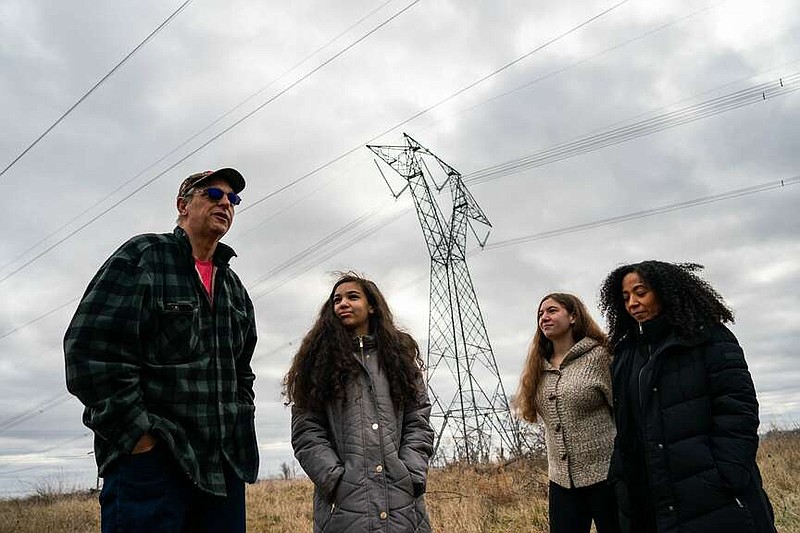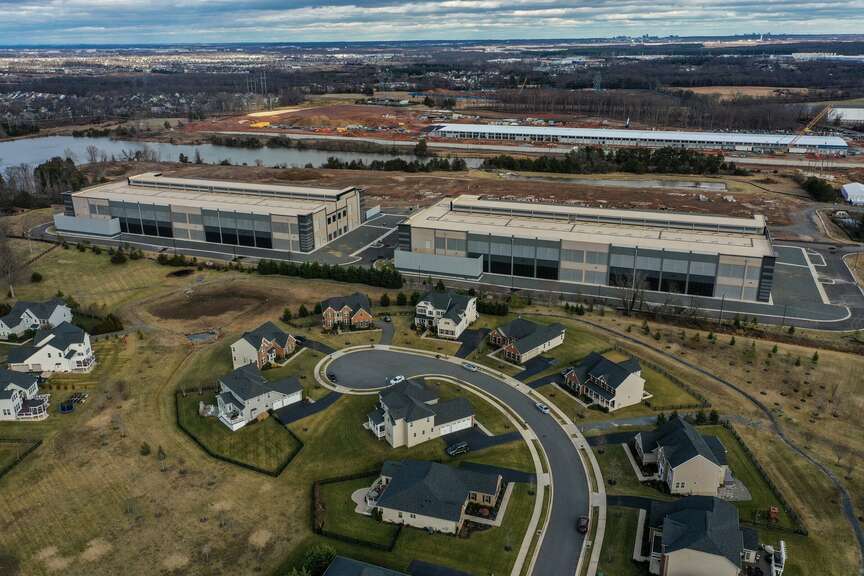CHARLES TOWN, W.Va. -- A helicopter hovers over the Gee family farm, the noisy rattle echoing inside their home in this rural part of West Virginia. It's holding surveyors who are eyeing space for yet another power line next to the property -- a line that will take electricity generated from coal plants in the state to address a drain on power driven by the world's internet hub in Northern Virginia 35 miles away.
There, enormous data centers with computers processing nearly 70% of global digital traffic are gobbling up electricity at a rate officials overseeing the power grid say is unsustainable unless two things happen: Several hundred miles of new transmission lines must be built, slicing through neighborhoods and farms in Virginia and three neighboring states. And antiquated coal-powered electricity plants that had been scheduled to go offline will need to keep running to fuel the increasing need for more power, undermining clean energy goals.
"It's not right," said Mary Gee, whose property already abuts two power lines that serve as conduits for electricity flowing toward the biggest concentration of data centers -- in Loudoun County, home to what's known as Data Center Alley."These power lines? They're not for me and my family. I didn't vote on this. And the data centers? That's not in West Virginia. That's a whole different state."
The $5.2 billion effort has fueled a backlash against data centers through the region, prompting officials in Virginia to begin studying the deeper impacts of an industry they have long cultivated for the hundreds of millions of dollars in tax revenue it brings to their communities.
Critics say it will force residents near the coal plants to continue living with toxic pollution, ironically to help a state -- Virginia -- that has fully embraced clean energy. And utility ratepayers in the affected areas will be forced to pay for the plan in the form of higher bills, those critics say.
But PJM Interconnection, the regional grid operator, says the plan is necessary to maintain grid reliability amid a wave of fossil fuel plant closures in recent years, prompted by the nation's transition to cleaner power.
Power lines will be built across four states in an effort that, relying on coal plants that were meant to be shuttered, is designed to keep the electric grid from failing amid spiking energy demands.
Cutting through farms and neighborhoods, the plan converges on Northern Virginia, where a growing data center industry will need enough extra energy to power 6 million homes by 2030.
With not enough of those green energy facilities connected to the grid yet, enough coal and natural gas energy to power 32 million homes is expected to be lost by 2030 at a time when the demand from the growing data center industry, electric vehicles and other new technology is on the rise, PJM says.
"The system is in a major transition right now, and it's going to continue to evolve," Ken Seiler, PJM's senior vice president in charge of planning, said in a December stakeholders' meeting about the effort to buy time for green energy to catch up. "And we'll look for opportunities to do everything we can to keep the lights on as it goes through this transition."
A NEED FOR POWER
Data centers that house thousands of computer servers and the cooling equipment needed for them to run have been multiplying in Northern Virginia since the late 1990s, spreading from the industry's historic base in Loudoun County to neighboring Prince William County and, recently, across the Potomac River into Maryland. There are nearly 300 data centers now in Virginia.
With Amazon Web Services pursuing a $35 billion data center expansion in Virginia, rural portions of the state are the industry's newest target for development.
The growth means big revenue for the localities that host the football-field-size buildings. Loudoun collects $600 million in annual taxes on the computer equipment inside the buildings, making it easier to fund schools and other services. Prince William, the second-largest market, collects $400 million per year.
But data centers also consume massive amounts of energy.
One data center can require 50 times the electricity of a typical office building, according to the U.S. Department of Energy. Multiple-building data center complexes, which have become the norm, require as much as 14 to 20 times that amount.
The demand has strained utility companies, to the point where Dominion Energy in Virginia briefly warned in 2022 that it may not be able to keep up with the pace of the industry's growth.
The utility -- which has since accelerated plans for new power lines and substations to boost its electrical output -- predicts that by 2035 the industry in Virginia will require 11,000 megawatts, nearly quadruple what it needed in 2022, or enough to power 8.8 million homes.
The smaller Northern Virginia Electric Cooperative recently told PJM that the more than 50 data centers it serves account for 59% of its energy demand. It expects to need to serve about 110 more data centers by July 2028.
Meanwhile, the amount of energy available is not growing quickly enough to meet that future demand. Coal plants have scaled down production or shut down altogether as the market transitions to green energy, hastened by laws in Maryland and Virginia mandating net-zero greenhouse gas emissions by 2045 and, for several other states in the region, by 2050.
Dominion is developing a 2,600-megawatt wind farm off Virginia Beach -- the largest such project in U.S. waters -- and the company recently gained state approval to build four solar projects.
But those projects won't be ready in time to absorb the projected gap in available energy. Opponents of PJM's plan say it wouldn't be necessary if more green energy had been connected to the grid faster, pointing to projects that were caught up in bureaucratic delays for five years or longer before they were connected.
Once more renewable energy is available, some of the power lines being built to address the energy gap may no longer be needed as the coal plants ultimately shut down, clean energy advocates say -- though utility companies contend the extra capacity brought by the lines will always be useful.
"Their planning is just about maintaining the status quo," Tom Rutigliano, a senior advocate for clean energy at the Natural Resources Defense Council, said about PJM. "They do nothing proactive about really trying to get a handle on the future and get ready for it."
'HOLDING ON TIGHT' TO COAL
The smoke from two coal plants near West Virginia's border with Pennsylvania billows over the city of Morgantown, adding a brownish tint to the air.
Nearby sits the 502 Junction substation, connected to those plants and a third one about 43 miles away via existing power lines, which will serve as a terminus for a western prong of the PJM plan for new lines that will extend to another substation in Frederick, Md., then south into Northern Virginia.
The owner of one of the Morgantown-area plants, Longview LLC, recently emerged from bankruptcy. After a restructuring, the facility is fully functioning, utilizing a solar farm to supplement its coal energy output.
The other two plants belong to the Ohio-based FirstEnergy Corp. utility, which had plans to significantly scale down operations there to meet a company goal of reducing its greenhouse gas emissions by nearly a third over the next six years.
The FirstEnergy plants have been equipped with carbon-capturing technology but they're still among the state's worst polluters, said Jim Kotcon, a West Virginia University plant pathology professor who oversees conservation efforts at the Sierra Club's West Virginia chapter.
The Harrison plant pumped out a combined 12 million tons of coal pollutants like sulfur and nitrous oxides in 2023, more than any other fossil fuel plant in the state, according to Environmental Protection Agency data. The Fort Martin plant, which has been operating since the late 1960s, emitted the state's highest levels of nitrous oxides in 2023, at 5,240 tons.
After PJM tapped the company to build a 36-mile-long portion of the planned power lines for $392 million, FirstEnergy announced in February that the two plants will continue operating until 2035 and 2040, citing the need for grid reliability.
The news has sent FirstEnergy's stock price up by 4% to about $37 a share last week, and was greeted with jubilation by West Virginia's coal industry.
"We welcome this, without question, because it will increase the life of these plants and hundreds of thousands of mining jobs," said Chris Hamilton, president of the West Virginia Coal Association. "We're holding on tight to our coal plants."
Since 2008, annual coal production in West Virginia has dipped by nearly half, to about 82 million tons, though the industry -- which contributes about $5.5 billion to the state's economy -- has rebounded some due to an export market to Europe and Asia, Hamilton said.
SOUNDING ALARMS
Keryn Newman, a Charles Town activist, has been sounding alarms in the small neighborhoods and farm communities along the path of the proposed power lines in West Virginia.
Newman, who in the late 2000s waged a successful campaign to stop a plan for a 765-kilovolt line extending through the area into Maryland before the data center boom, sees the battle in terms of the more affordable, quieter lifestyle she and her neighbors cherish.
Because FirstEnergy prohibits any structure from interfering with a power line, building a new line along the right of way -- which would be expanded to make room for the third line -- would mean altering the character of residents' properties, Newman said.
"It gobbles up space for play equipment for your kid, a pool or a barn," she said. "And a well or septic system can't be in the right of way."
A FirstEnergy spokesperson said the company would compensate property owners for any land needed, with eminent domain proceedings a last resort if those property owners are unwilling to sell.
Some have accepted that more power lines will come through and seem open to selling to FirstEnergy and moving away.
Pam and Gary Gearhart fought alongside Newman against the defeated 765-kilovolt line, which would have forced them to move a septic system near FirstEnergy's easement. But when Newman showed up recently to their Harpers Ferry-area neighborhood to discuss the new PJM plan, the couple appeared unwilling to fight again.ƒ
Next door, another family had already decided to leave, the couple said, and was in the midst of loading furniture into a truck when Newman showed up.
"They're just going to keep okaying data centers; there's money in those things," Pam Gearhart said about local governments in Virginia benefiting from the tax revenue. "Until they run out of land down there."

